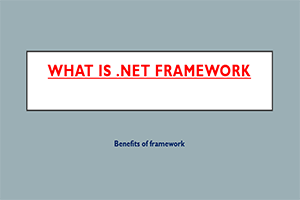Features of Net framework | What is .NET Framework
.NET Framework is an important windows component that supports the execution of applications created by using various programming languages, such as Visual C#, Visual Basic, Visual F#, and Visual C++.


The .NET Framework consists of a virtual execution system called the CLR and a set of class libraries.
CLR is a Microsoft product of the Common Language Infrastructure (CLI), which is an international standard and a basis for creating execution and development environments in which languages and libraries work together.
Table of Contents
features of .net framework


Features of .Net framework
Consistent programming model:
It provides a consistent object-oriented programming model across different languages. You can use this model to create programs for performing different tasks, such as connecting to and retrieving data from databases, and reading and writing in files.
Cross-platform support:
Specifies that any windows platform that supports CLR can execute .NET application. That is, .NET application enables interoperability between different windows OS.
Language interoperability:
Enables code written in different languages to interact with each other. This allows the reusability of code and improves the efficiency of the development process.
For Example, In an Active Server Pages.NET (ASP.NET) application created using visual basic language, you can inherit a C# class in the application.
The CLR has built-in support for language interoperability. However, there is no assurance that the code is written can be utilized by other developers using another programming language.
Therefore, to ensure multi-language code interoperability, a set of language features and rules for using them, called the CLS, is defined. Any component that follows these rules and exposes only CLS features is said to be CLS-compliant.
Automatic management of resource:
Specifies that in .NET, you do not need to manually free the application resources, such as files, memory, network, and database connections. .NET Framework provides a feature called CLR that automatically tracks the resource usage and helps you in performing the task of manual resource management.
Ease of deployment:
Specifies that the .NET Framework installs applications or components that do not affect the existing applications. In most cases, to install an application, you need to copy the application along with its components on the target computer.
In .NET, applications are deployed in the form of assemblies. Therefore, registry entries are not required to store information about components and applications.
In addition, assemblies store information about different versions of a single component used by an application. Therefore, the version problem is also eliminated in .NET Framework.
Also Read:
Features of net framework
I hope you like the post (Features of .NET framework). Don’t forget to share it.
